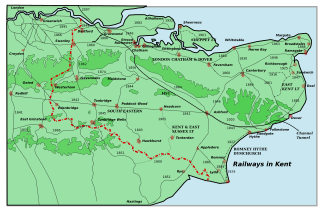North Kent line
| North Kent Line | |
|---|---|

The North Kent Line, shown with other railway lines in Kent.
|
|
| Overview | |
| Type | Commuter rail, Suburban rail |
| System | National Rail |
| Status | Operational |
| Locale |
Greater London South East England |
| Termini |
London Charing Cross London Cannon Street Gillingham Dartford |
| Operation | |
| Owner | Network Rail |
| Operator(s) | Southeastern |
| Depot(s) |
Slade Green Grove Park Gillingham |
| Rolling stock |
Class 375 "Electrostar" Class 376 "Electrostar" Class 395 "Javelin" Class 465 "Networker" Class 466 "Networker" |
| Technical | |
| Number of tracks | 2 |
| Track gauge | 1,435 mm (4 ft 8 1⁄2 in) standard gauge |
| Electrification | 750 DC third rail |
The North Kent Line is a railway which runs from a junction of Britain's South East Main Line, east of St Johns railway station, Greater London to a point south-west of Strood station by the River Medway in Medway where it links to the Chatham Main Line and where services usually terminate at Gillingham or closer at Dartford along the north coast/estuary. The London terminus is Charing Cross station.
The North Kent Line was the means by which the South Eastern Railway (SER) was able to connect its system to London at London Bridge. In 1846 the SER purchased the Thames and Medway Canal tunnel near Higham and laid railway tracks through it; in 1847 trains were working through from the Strood terminus, on the River Medway to Gravesend. From 30 July 1849 the line was extended, via Blackheath, to a junction with the London and Greenwich Railway at North Kent East Junction, near Deptford, and through trains were now able to operate.
The line is electrified (750 V DC third rail). Electrification was initially to Dartford (6 June 1926) and was extended to Gillingham by World War Two.
...
Wikipedia
